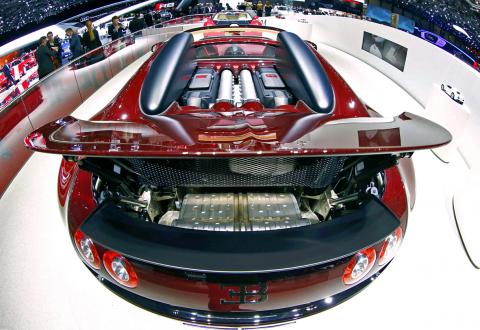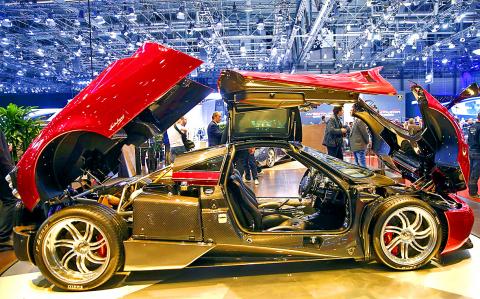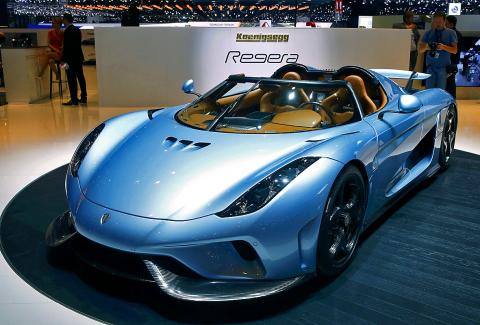They have fighter jet-type accelerations, custom-made interiors and seven-figure price tags: “supercars” are center stage at the Geneva International Motor Show, even as one of its legendary stars is bowing out.
The last Bugatti Veyron ever to be made has pride of place at the show for auto enthusiasts to bid farewell after the brand announced last month that it had sold the 450th and final model of the car with a 16-cylinder monster engine that produces up to 1,200 horsepower.
“With the Veyron, we created a modern icon, and this show is an opportunity to put the car on a pedestal and celebrate, and say thank you to everyone involved, and close the chapter,” Bugatti head of sales Stefan Brungs said.

Photo: Reuters
Since the Veyron was unveiled to the world at the beginning of the 2000s, competitors have rushed to carve out a place in this exclusive world of cars that only the ultra-rich can afford.
Sweden’s Koenigsegg, for instance, boasts it makes not “supercars,” or even “hypercars,” but full-blown “megacars.”
The company is presenting its Regera at the Geneva show, which opened to the public on Thursday. The car comes with a hybrid powertrain that produces 1,500 horsepower, capable of accelerating from 0 to 400kph in 20 seconds.

Photo: Reuters
That is about twice the horsepower of a regular Formula 1 car, though the Regera is much heavier.
“Now it seems to be pretty normal to have almost 1,000 horsepower,” says Jens Sverdrup, the brand’s head of sales.
The cost? About US$2 million or more, depending on what you want added.

Photo: Reuters
That is the amount the thrill-seeking rich will also need to fork out for McLaren’s P1 GTR.
Like Aston Martin’s Vulcan, which also premiered in Geneva, it is a car destined for “gentlemen drivers” that can only be used on special tracks, and the price tag comes with piloting lessons included.
However, Dave Eden, spokesman for the brand made famous by its Formula 1 success, says that the P1 GTR will only be made available to those who already own the P1 road car — a hybrid supercar unveiled in 2012 that already costs more than 1 million euros (US1.08 million).

Photo: Reuters
And orders for the GTR have been limited to just 40, a figure almost attained, he said.
“We’ve got people flying in from all over the world to see the cars,” Eden added.
While the stalls of more generalist brands are open to all, those of the “supercar” manufacturers are surrounded by glass barriers and entrances are guarded by imposing security men.

Photo: Bloomberg
In front of the stalls belonging to Italy’s Ferrari and Lamborghini, men gather in quest of selfies — and also photographs of models in figure-hugging dresses posing next to the vehicles of their desire.
Some brands, like Italy’s Pagani, make an effort for the vast majority of visitors who will never have the means to pay for such “supercars” by giving out posters.
“We sell cars, but we give as a present dreams to car lovers all around the world,” Pagani spokesman Luca Venturi says. “We are the kind of guys who used to have a Lamborghini Countach poster on the wall.”
The brand manufacturers the Huayra, a carbon fiber Batmobile look-alike whose interior is made of leather.
The price: 1.3 million euros, VAT not included.
As for Bugatti, its Veyron may be bowing out, but the brand owned by Volkswagen has no intention of leaving it without heirs.
Bugatti still holds the speed record for a production car at 431kph, and its next vehicle “will be fascinating and even better than what you see here,” Brungs says.
“The car will come most probably next year,” he says. “We love competition, and if someone tries to beat us, we’ll take this as a challenge, and we enjoy striking back.”

CAUTIOUS RECOVERY: While the manufacturing sector returned to growth amid the US-China trade truce, firms remain wary as uncertainty clouds the outlook, the CIER said The local manufacturing sector returned to expansion last month, as the official purchasing managers’ index (PMI) rose 2.1 points to 51.0, driven by a temporary easing in US-China trade tensions, the Chung-Hua Institution for Economic Research (CIER, 中華經濟研究院) said yesterday. The PMI gauges the health of the manufacturing industry, with readings above 50 indicating expansion and those below 50 signaling contraction. “Firms are not as pessimistic as they were in April, but they remain far from optimistic,” CIER president Lien Hsien-ming (連賢明) said at a news conference. The full impact of US tariff decisions is unlikely to become clear until later this month

With an approval rating of just two percent, Peruvian President Dina Boluarte might be the world’s most unpopular leader, according to pollsters. Protests greeted her rise to power 29 months ago, and have marked her entire term — joined by assorted scandals, investigations, controversies and a surge in gang violence. The 63-year-old is the target of a dozen probes, including for her alleged failure to declare gifts of luxury jewels and watches, a scandal inevitably dubbed “Rolexgate.” She is also under the microscope for a two-week undeclared absence for nose surgery — which she insists was medical, not cosmetic — and is

GROWING CONCERN: Some senior Trump administration officials opposed the UAE expansion over fears that another TSMC project could jeopardize its US investment Taiwan Semiconductor Manufacturing Co (TSMC, 台積電) is evaluating building an advanced production facility in the United Arab Emirates (UAE) and has discussed the possibility with officials in US President Donald Trump’s administration, people familiar with the matter said, in a potentially major bet on the Middle East that would only come to fruition with Washington’s approval. The company has had multiple meetings in the past few months with US Special Envoy to the Middle East Steve Witkoff and officials from MGX, an influential investment vehicle overseen by the UAE president’s brother, the people said. The conversations are a continuation of talks that

Alchip Technologies Ltd (世芯), an application-specific integrated circuit (ASIC) designer specializing in artificial-intelligence (AI) chips, yesterday said that small-volume production of 3-nanometer (nm) chips for a key customer is on track to start by the end of this year, dismissing speculation about delays in producing advanced chips. As Alchip is transitioning from 7-nanometer and 5-nanometer process technology to 3 nanometers, investors and shareholders have been closely monitoring whether the company is navigating through such transition smoothly. “We are proceeding well in [building] this generation [of chips]. It appears to me that no revision will be required. We have achieved success in designing